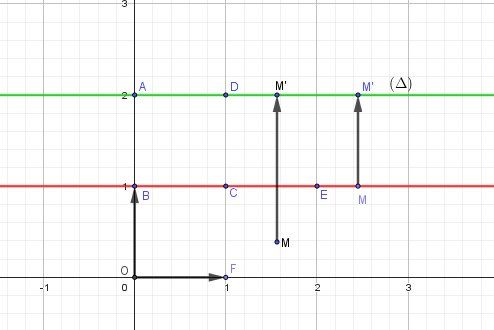Application affine , dans le plan urgent
-
MMMounah dernière édition par
Bonsoir
Le plan est muni d'un repère orthonormé (0; i; J) dans lequel on considère les points
A(0;2); B(0; 1); C(1; 1); D(1; 2)et E(2; 1)
Soit f l'application affine du plan qui transforme le point O en A et dont l'application linéaire associée est notée ϕ\phiϕ
On suppose que pour tout point M de la droite (BC), on aVecMf(M)=vecjVecMf(M)= vecjVecMf(M)=vecj- a) Déterminer f(B) et f(C)
b) Déterminer la matrice de ‹ dans la base (I;j) - Soit M un point du plan de coordonnées (x, y) dans le repère(0;i;j). Démontrer que
$\vecMf(M) = (2 - y)j - Démontrer que fof = f. En déduire la nature et les éléments caractéristiques de f.
aidez moi svp
- a) Déterminer f(B) et f(C)
-
MMMounah dernière édition par
@MMounah bonsoir
@Black-Jack @mtschoon
-
mtschoon dernière édition par mtschoon

@MMounah , bonjour,
Quelques pistes à creuser,
Schéma
Notation : M′=f(M)M'=f(M)M′=f(M)

1 ) En utilisant les hypothèses, tu peux déduire :
f(O)=Af(O)=Af(O)=A
f(B)=Af(B)=Af(B)=A
f(C)=Df(C)=Df(C)=DSoit m la matrice de Φ\PhiΦ
Tu dois trouver Φ(i→)\Phi(\overrightarrow{i})Φ(i) et Φ(j→)\Phi(\overrightarrow{j})Φ(j)
Φ(i→)=Φ(BC→)=f(B)f(C→)=AD→\Phi(\overrightarrow{i})=\Phi(\overrightarrow{BC})=\overrightarrow{f(B)f(C})=\overrightarrow{AD}Φ(i)=Φ(BC)=f(B)f(C)=AD
Φ(j→)=Φ(OB→)=f(O)f(B→)=AA→=0→\Phi(\overrightarrow{j})=\Phi(\overrightarrow{OB})=\overrightarrow{f(O)f(B})=\overrightarrow{AA}=\overrightarrow{0}Φ(j)=Φ(OB)=f(O)f(B)=AA=0D'où m=(1 00 0)m=\begin{pmatrix}1 \ \ 0\cr 0\ \ 0\end{pmatrix}m=(1 00 0)
2 ) M(x,y)M(x,y)M(x,y)
f(M)=f(O)+Φ(OM→)=A+Φ(OM→)f(M)=f(O)+\Phi(\overrightarrow{OM})=A+\Phi(\overrightarrow{OM})f(M)=f(O)+Φ(OM)=A+Φ(OM)Tu dois trouver : f(M)f(M)f(M) pour coordonnées (x,2)(x,2)(x,2)
Puis Mf(M)→\overrightarrow{Mf(M)}Mf(M) a pour coordonnées (0,2−y)(0,2-y)(0,2−y) d'où la réponse proposée
3 ) MMM a pour coordonnées (x,y)(x,y)(x,y)
f(M)f(M)f(M) a pour coordonnées (x,2)(x,2)(x,2)
f(f(M))f(f(M))f(f(M)) a pour coordonnées (x,2)(x,2)(x,2)
d'où fof=ffof=ffof=fTu dois déduire que fff est la projection orthogonale sur la droite (Δ)(\Delta)(Δ) d'équation y=2y=2y=2
Tout ceci est à détailler avec soin.
Bon travail.
-
mtschoon dernière édition par

@MMounah , si tu as besoin de détails sur les applications affines, tu peux consulter éventuellement ici :https://webusers.imj-prg.fr/~christian.blanchet/enseignement/2013-14/L3/ch2_appl_affines.pdf
-
MMMounah dernière édition par
@mtschoon bonsoir
Madame j’ai pas bien compris la question 2.
-
mtschoon dernière édition par mtschoon

@MMounah , bonjour,
J'explicite un peu la question 2)
J'utilise les notations du lien que je t'ai donné.
Adapte si besoin.f(M)=f(O)+Φ(OM→)f(M)=f(O)+\Phi(\overrightarrow{OM})f(M)=f(O)+Φ(OM)
f(O)=A=(02)f(O)=A=\begin{pmatrix}0\cr 2\end{pmatrix}f(O)=A=(02)
OM→=(xy)\overrightarrow{OM}=\begin{pmatrix}x\cr y\end{pmatrix}OM=(xy)mmm étant matrice de Φ\PhiΦ calaculée précédemment
Φ(OM→)=m×(xy)\Phi(\overrightarrow{OM})=m\times \begin{pmatrix}x\cr y\end{pmatrix}Φ(OM)=m×(xy)
Φ(OM→)\Phi(\overrightarrow{OM})Φ(OM)=(0 10 0)×(xy)=(x0)\begin{pmatrix}0 \ \ 1\cr 0\ \ 0\end{pmatrix} \times \begin{pmatrix}x\cr y\end{pmatrix}=\begin{pmatrix}x\cr 0\end{pmatrix}(0 10 0)×(xy)=(x0)
Donc
f(M)=(02)+(x0)=(x2)f(M)=\begin{pmatrix}0\cr 2\end{pmatrix}+\begin{pmatrix}x\cr 0\end{pmatrix}=\begin{pmatrix}x\cr 2\end{pmatrix}f(M)=(02)+(x0)=(x2)
Conséquence :
Mf(M)→=(x2)−(xy)=(x−x2−y)=(02−y)\overrightarrow{Mf(M)}=\begin{pmatrix}x\cr 2\end{pmatrix}-\begin{pmatrix}x\cr y\end{pmatrix}=\begin{pmatrix}x-x\cr 2-y\end{pmatrix}=\begin{pmatrix}0\cr 2-y\end{pmatrix}Mf(M)=(x2)−(xy)=(x−x2−y)=(02−y)Tu tires la conclusion.